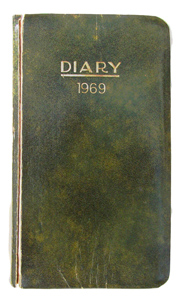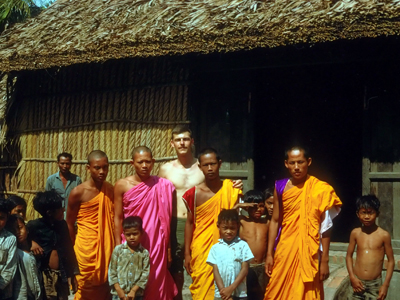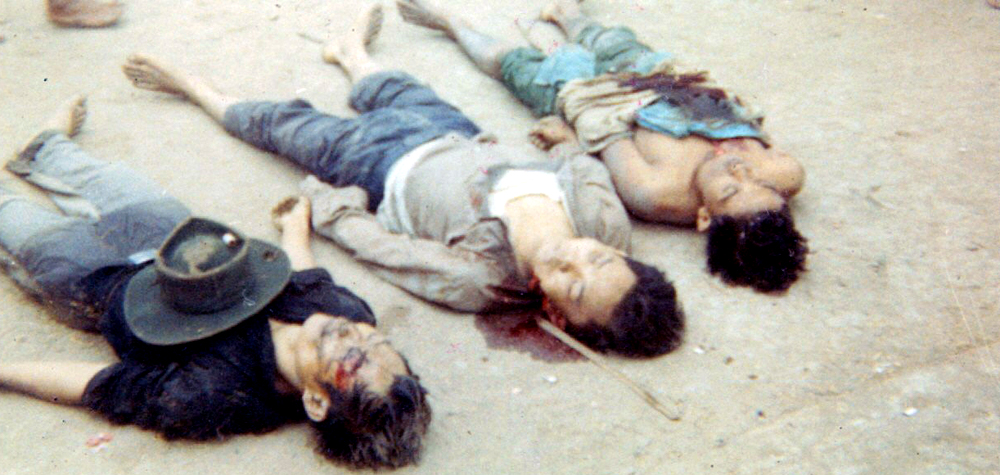Chapter 3
The 168 Company
FEBRUARY 22, 1969
Diary Entry:
Up at 0730. Got washed up. Heard gunfire about a half mile away, near the pagoda.C Mostly M16 fire. The Dai Úy told us that the 168 Company was under attack and had already killed 3 VC.D Guerrero and I rode up by sampan. They had the dead VC lying on the ground and all three had at least one bullet in the head. One was a known Vietcông platoon leader. His stomach was blown open and bleeding profusely. People took pictures. The 168 Company also wounded 8 Vietcông, captured two Chicom carbines, one U.S. hand grenade, 1 Chicom grenade and 1 U.S. carbine.
Welcome to Vietnam! Today was the start of my fifth day in the field. I had been in the Army for just about 2 years, but all of the training and all of the war stories I had heard could not possibly prepare me to see my first freshly shot dead bodies.
SFC Guerrero grabbed his camera and weapon and took along the naive new Lieutenant Amon. I found myself warily disembarking the sampan with Guerrero near the pagoda. To my right, I noticed a felled coconut tree, blown in two. Part of the tree lay in the water.
The story later unfolded: At approximately 3 a.m., fifteen Vietcông had entered Hóa Quản from the north end, where I had been the day before. They set up an ambush along the heavily traveled trail running along the canal in the center of Hóa Quản. Using a coconut tree as the focal point of the ambush, they strapped to it a large unexploded artillery round, and waited in the jungle with a detonating device.
Our 168 Company soldiers had awakened and were preparing for another operation. As was their habit, some of them wandered up the trail in a group toward the pagoda for their morning "caphe" and pastries at a little grass hut-turned coffee shop in the village. When they reached the coconut tree, the VC detonated the explosive with the intent of killing some and incapacitating the rest, so they could finish them off with small-arms fire and quickly leave. The force of the explosion went the wrong way, however, and did nothing more than cut down the coconut tree. The 168 scrambled for cover uninjured, and used their M16 rifles to pour a heavy volume of fire at the waiting VC, who began taking casualties.
Thiéu Úy Hungl ran to the scene with the remainder of his platoon and joined in, pouring more firepower at the VC, who were by now on the defensive, dragging off wounded comrades from the firefight. The tables continued turning as the rest of the 168 arrived. Three of the most defiant of the VC, led by a local Vietcông platoon leader, continued the firefight while climbing into a sampan to escape. While two of them returned fire from the sampan, the third stood up in the back of the boat, yanking on the motor, trying to get it started.
Hungl bravely advanced his men toward the bank of the canal for a clearer shot and managed to pick off the Vietcông who was standing up, pulling on the starter cord. Then, in a hail of bullets and with no mercy, the whole platoon riddled the other two inhabitants, capsizing the boat.
As Guerrero and I climbed onto the bank of the canal, people from all over the village were moving cautiously toward the crowd in front of the pagoda. Trung Úy Ouys greeted us in his underwear.
I could see three bodies sprawled out in the center of the crowd. Some of our soldiers had already disrespectfully placed lit cigarettes in the mouths of the dead. The Vietcông platoon leader had been fished out of the water alive and conscious, but not for long. One of my 168 soldiers was so pissed at having almost been killed that he walked over to him and exacted revenge for having the hell scared out of him. He fired his entire magazine of 20 rounds into his stomach while he was still alive.
The bullets ricocheted off the concrete slab, came back up through his mid-section and caused his body to dance and twitch as the gunfire once again sent civilians and soldiers scurrying for cover. When it was over, one of the monks threw a blue dish towel over the mess that was once his midsection, partially to discourage the dozens of flies that had already converged and also to cover the contents of what was once his stomach.
Each of the Vietcông were then systematically shot in the head. Years later, I read accounts of ground actions in other wars, and this behavior is not atypical, an act simultaneously born of fear and mercy. On some, parts of their brains were visible from the exit wound. I remember how odd their faces appeared. The final bullet to the head of the platoon leader distorted his facial features, causing an asymmetrical shifting of his cheek bone. I could tell he had probably been a good-looking young man just minutes before. He was the oldest, approximately 21 years of age. One of our soldiers went over and kicked the head of the one in the middle and the back of his head was gone.
I had seen bodies in funeral parlors before. They never particularly affected me too much. Funeral parlor bodies are always cleaned up, dressed up, arms folded, nice and neat. No muddy wet hair, uncombed and disheveled. No cigarettes dangling from their mouths. Funeral parlor corpses are refined, dignified. These were warm, fresh-killed bodies - no chance to get cleaned up or change out of their wet clothes to get their picture taken. Warm, freshly-killed, muddy bodies drying off in the sun.
I remember two things vividly: the smell of the Vietnamese cigarettes and the flies. The flies were the first on the scene. The delicious, wet, blood-soaked bodies were irresistible to them. They landed in embarrassing places searching for a meal. A fly landed on the young man’s lips, then walked to the opening in his nose, inspecting the hole as if pondering whether or not to enter. No, it decided to move toward the bloody side of his head, to wander through the blood-soaked, jet-black hair. Everyone was very quiet. Only the sound of the flies pervaded, arriving in swarms, buzzing in short bursts to get as much as they could. I felt like shooing them, they didn’t belong here, they didn’t have the right to make it even more dehumanizing.
Vietnamese cigarette smoke has a smell unlike any tobacco grown in the United States. Their cigarettes have a distinctively sweet smell, a pungently curious aroma which, once smelled, is difficult to forget. Our senses have a memory for such things, just as our minds have a memory to store facts and sights we see. The sight of the fly-ridden bodies combined with the redolence of the cigarettes formed a double hit on my consciousness. For the rest of the year the smell of those cigarettes was synonymous with death. For the rest of my life I’ll not forget the smell of sweet, overpowering, pungent death.
Guerrero began taking photographs of the dead VC and I did the same, watching him and imitating his cocky composure. I lit up a cigarette also. Hey, got to appear nonchalant now and look unaffected. Take a few more pictures, don’t be scared. It ain’t no big thing.
 In the midst of this ruse, I glanced over toward the pagoda. Some young monks were standing in a group at the entrance to the pagoda and they didn’t look at all amused. They looked sad, concerned, the circus was getting out of hand. Suddenly I was ashamed. I put the camera away and stopped the pretense. What the hell am I doing?
In the midst of this ruse, I glanced over toward the pagoda. Some young monks were standing in a group at the entrance to the pagoda and they didn’t look at all amused. They looked sad, concerned, the circus was getting out of hand. Suddenly I was ashamed. I put the camera away and stopped the pretense. What the hell am I doing?
That evening I wrote in my diary the words “people took pictures.” I couldn’t bring myself to write “I took pictures,” because I was ashamed. I knew it was wrong, even back on the evening of the 22nd when I wrote it in the diary. Taking pictures of dead bodies was a cowardly and insensitive thing to do. Later, I almost felt that, by having done it, I became part of the act - certainly part of the circus.
That was to be the first and last time I took part in that behavior. That night I couldn’t sleep, thinking about the bodies I had taken pictures of. Who were they, really? Did they have any loved ones? What sort of children had they been? Surely, they must have family members. What will the families think when they are notified that their loved one was killed? Worse, what grief will they experience when they learn that the bodies were so publicly and irreverently ridiculed?
How strong their political beliefs must have been to propel them to that river to kill us. Moments before the snap of my shutter they had been healthy, functioning human beings. Then they were laid out in front of the pagoda, the entire village glaring at the spectacle.
However grotesque, the 168 Company had sent an unmistakable message to the Vietcông: stay the hell out of Hóa Quản Village. That day was my fifth day in the field in Vietnam, an early introduction to the killing and brutality. Vietnam hadn’t wasted any time punching me in the face.
I wanted an adventure and I wanted to see for myself. Now I still had a whole year to go. I’d better watch it, or I might wind up like Mayo Parks, getting shot. Or maybe worse: I could wind up wet and muddy with a bullet in my head and a cigarette dangling from my lips.
ALL RIGHTS RESERVED. COPYING, REPRODUCING, BORROWING OR USING ANY OF THE MATERIAL CONTAINED IN THIS WEBSITE AND/OR BOOK WITHOUT THE AUTHOR'S PERMISSION IS HEREBY STRICTLY PROHIBITED.
